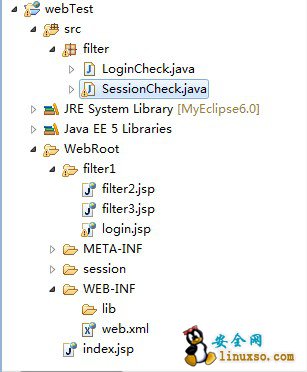用filter实现web程序的统一认证
现在web程序很多都用到统一认证这东西,刚好看《jsp2.0技术手册》看到这块,看完感觉有点模糊,所以就自己写代码试了一下,花了好长一段时间,原因终于在今天找到了,并且成功解决,但是我并没有因此而感到自豪,因为我越来越感觉自己蠢了,蠢得无可救药。废话不说了,看下面的东西吧:
用filter实现统一认证我用了5个页面,分别为:login.jsp,filter2.jsp,filter3.jsp,LoginCheck.java,SessionCheck.java.其中最主要的是SessionCheck.java.另外还需要配置web.xml文件,这个千万不能忘记哦。
下面是我的web程序的结构图:

下面看下各个页面的代码(内含很多注释,方便理解):
SessionCheck.java:
1 package filter; 2 3 import java.io.IOException; 4 import javax.servlet.Filter; 5 import javax.servlet.FilterChain; 6 import javax.servlet.FilterConfig; 7 import javax.servlet.ServletContext; 8 import javax.servlet.ServletException; 9 import javax.servlet.ServletRequest; 10 import javax.servlet.ServletResponse; 11 import javax.servlet.http.HttpServletRequest; 12 import javax.servlet.http.HttpServletResponse; 13 import javax.servlet.http.HttpSession; 14 15 16 public class SessionCheck implements Filter { 17 18 private ServletContext context; 19 private String targetUri; 20 21 public void destroy() { 22 // TODO Auto-generated method stub 23 24 } 25 26 public void doFilter( 27 ServletRequest request, 28 ServletResponse response, 29 FilterChain chain) throws IOException, ServletException { 30 // TODO Auto-generated method stub 31 HttpServletRequest httpRequest = (HttpServletRequest)request; 32 HttpServletResponse httpResponse = (HttpServletResponse) response; 33 /** 34 * getSession(false)此方法如果得不到session,也不会自动创建一个session 35 * 36 * 插曲:看到getSeesion(false)表示之前没看到过,不知道意思,本能的猜测是: 37 * 如果没有得到sesson,则返回null,如果参数为true,得不到session那就重新创建一个 38 * 因为只是猜测,所以上csdn查了下,结果看到一帖子,说的果断和我的理解相反,接着看,下面各种各样的回复,琳琅满目 39 * 当然,在找之前已经用debug验证过了,我的想法只要不是验证方法错了那我的理解肯定是对的 40 * 结果在csdn看到几乎一样的问题,而且一楼回答刚好跟我的完全相反,并且楼主还给了30分,这让我不由的蛋疼了下, 41 * 结论完全相反呀,继续忐忑的往下看,一哥们什么都没解释,直接把关于session的官方文档给拉出来贴着,全英文,还好哥虽然没过6鸡 42 * 但也还是能看懂几个abc的,意思跟我理解一样,忐忑的心终于有点放下了,继续往下看,一看id,俨然是楼主本人,一看内容,我热泪盈眶 43 * 楼主你Y真是好人啊,一楼理解完全相反你Y居然给30分,你妹啊,害得我还犹豫了半天,纳闷了半天,不过还好你出来纠正了你之前的 44 * NC行径,也算是一大进步。 45 */ 46 HttpSession session = httpRequest.getSession(false); 47 48 if(session != null){ 49 String passed = (String)session.getAttribute("passed"); 50 if("true".equals(passed)){ 51 chain.doFilter(httpRequest, httpResponse); 52 /** 53 * return 说明filter在执行了chain.doFilter之后会返回来继续执行原先的filter 54 * 相当于一个递归调用 55 * return 下面的代码表示执行失败的情况 56 */ 57 return; 58 }else if("passing".equals(passed)){ 59 /** 60 * httpRequest.getRequestURL()获取绝对路径 61 * 例如http://127.0.0.1:8088/webTest/filter1/login.jsp 62 * 63 * httpRequest.getRequestURI()获取相对路径。 64 * /webTest/filter/LoginCheck,其中filter/LoginCheck为jsp页面中form表单的action值 65 * 对应的Servlet的<url-pattern>要写成/filter/LoginCheck 66 */ 67 if("/webTest/filter/LoginCheck".equals(new String(httpRequest.getRequestURI()))){ 68 chain.doFilter(httpRequest, httpResponse); 69 return; 70 } 71 } 72 /** 73 * 如果之前的filter执行均失败,则说明这个session中的passed认证已经是错误的,必须删除 74 */ 75 session.removeAttribute("passed"); 76 } 77 /** 78 * requestUrl保存当前请求的url 79 * query保存当前请求下的参数 80 */ 81 StringBuffer requestUrl = new StringBuffer(httpRequest.getRequestURI()); 82 String query = httpRequest.getQueryString(); 83 if(null != query){ 84 requestUrl.append(query); 85 } 86 /** 87 * 设置request范围内的originalUri(认证之前的请求地址),用于在login页面获取,并可以通过隐藏参数的形式把这个值传递到LoginCheck 88 * 当登录之后就可以直接转到login认证之前的页面 89 */ 90 httpRequest.setAttribute("originalUri", new String(requestUrl)); 91 httpRequest.getRequestDispatcher(targetUri).forward(httpRequest, httpResponse); 92 } 93 94 public void init(FilterConfig config) throws ServletException { 95 // TODO Auto-generated method stub 96 this.context = config.getServletContext(); 97 /** 98 * 获取filter的初始化参数,当需要认证的时候都会跳转到targetUri指定页面,一般都是登录页面 99 */ 100 this.targetUri = config.getInitParameter("targetUri"); 101 } 102 103 104 }
LoginCheck.java:
1 package filter; 2 3 import java.io.IOException; 4 import javax.servlet.ServletException; 5 import javax.servlet.http.HttpServlet; 6 import javax.servlet.http.HttpServletRequest; 7 import javax.servlet.http.HttpServletResponse; 8 import javax.servlet.http.HttpSession; 9 10 public class LoginCheck extends HttpServlet { 11 12 private static final long serialVersionUID = -4075113258177758412L; 13 14 protected void doPost(HttpServletRequest request,HttpServletResponse response) 15 throws IOException,ServletException{ 16 String user = request.getParameter("user"); 17 String pwd = request.getParameter("pwd"); 18 String targetUri = request.getParameter("originalUri"); 19 20 if(!"LH123".equals(user) || !"123LH".equals(pwd)){ 21 System.out.println("认证失败"); 22 throw new ServletException("认证失败"); 23 } 24 /** 25 * 认证成功的情况 26 */ 27 HttpSession session = request.getSession(); 28 session.setAttribute("passed", "true"); 29 request.setAttribute("user", user); 30 request.setAttribute("pwd", pwd); 31 if(!"".equals(targetUri)){ 32 /** 33 * SessionCheck中保存入的之前的请求的uri的格式为:/webTest/filter/filter3.jsp 34 * 而getRequestDispatcher这种方法传递过去的是一个相对路径,不需要再加上/webTest 35 * 这个方法可以把页面表单的值传递到另外一个页面,而不只是纯粹的跳转 36 */ 37 request.getRequestDispatcher(targetUri.substring(8)).forward(request, response); 38 }else{ 39 response.sendRedirect("http://127.0.0.1:8088/webTest/filter1/filter2.jsp"); 40 } 41 } 42 }
login.jsp:
 login.jsp
login.jsp
<%@ page language="java" import="java.util.*" pageEncoding="UTF-8"%> <%@ taglib prefix ="c" uri="http://java.sun.com/jsp/jstl/core"%> <% String path = request.getContextPath(); String basePath = request.getScheme()+"://"+request.getServerName()+":"+request.getServerPort()+path+"/"; %> <!DOCTYPE HTML PUBLIC "-//W3C//DTD HTML 4.01 Transitional//EN"> <html> <head> <base href="<%=basePath%>"> <title>测试filter</title> <meta http-equiv="pragma" content="no-cache"> <meta http-equiv="cache-control" content="no-cache"> <meta http-equiv="expires" content="0"> <meta http-equiv="keywords" content="keyword1,keyword2,keyword3"> <meta http-equiv="description" content="This is my page"> <!-- <link rel="stylesheet" type="text/css" href="styles.css"> --> </head> <body> <c:set var = "passed" value = "passing" scope = "session"></c:set> <form action = "filter/LoginCheck" method = "post"> <table> <tr> <th>用户账号:</th> <td><input type = "text" name = "user" value = ""/></td> </tr> <tr> <th>登录密码:</th> <td><input type = "password" name = "pwd" value = ""/></td> </tr> <th> <input type = "hidden" name = "originalUri" value = "${requestScope.originalUri}"/> </th> <tr> <td><input type = "submit" name = "submit" value = "提交"/></td> </tr> </table> </form> </body> </html>
filter2.jsp:
 filter2.jsp
filter2.jsp
1 <%@ page language="java" import="java.util.*" pageEncoding="UTF-8"%> 2 <%@ taglib prefix ="c" uri ="http://java.sun.com/jsp/jstl/core"%> 3 <% 4 String path = request.getContextPath(); 5 String basePath = request.getScheme()+"://"+request.getServerName()+":"+request.getServerPort()+path+"/"; 6 %> 7 8 <!DOCTYPE HTML PUBLIC "-//W3C//DTD HTML 4.01 Transitional//EN"> 9 <html> 10 <head> 11 <base href="<%=basePath%>"> 12 13 <title>My JSP 'filter2.jsp' starting page</title> 14 15 <meta http-equiv="pragma" content="no-cache"> 16 <meta http-equiv="cache-control" content="no-cache"> 17 <meta http-equiv="expires" content="0"> 18 <meta http-equiv="keywords" content="keyword1,keyword2,keyword3"> 19 <meta http-equiv="description" content="This is my page"> 20 <!-- 21 <link rel="stylesheet" type="text/css" href="styles.css"> 22 --> 23 24 </head> 25 26 <body> 27 HHHHH 28 29 </body> 30 </html>
filter3.jsp:
filter3.jsp
1 <%@ page language="java" import="java.util.*" pageEncoding="UTF-8"%> 2 <%@ taglib prefix="c" uri="http://java.sun.com/jsp/jstl/core"%> 3 <% 4 String path = request.getContextPath(); 5 String basePath = request.getScheme()+"://"+request.getServerName()+":"+request.getServerPort()+path+"/"; 6 %> 7 8 <!DOCTYPE HTML PUBLIC "-//W3C//DTD HTML 4.01 Transitional//EN"> 9 <html> 10 <head> 11 <base href="<%=basePath%>"> 12 13 <title>My JSP 'filter3.jsp' starting page</title> 14 15 <meta http-equiv="pragma" content="no-cache"> 16 <meta http-equiv="cache-control" content="no-cache"> 17 <meta http-equiv="expires" content="0"> 18 <meta http-equiv="keywords" content="keyword1,keyword2,keyword3"> 19 <meta http-equiv="description" content="This is my page"> 20 <!-- 21 <link rel="stylesheet" type="text/css" href="styles.css"> 22 --> 23 24 </head> 25 26 <body> 27 <c:out value="${user}"></c:out> <br> 28 <c:out value="${pwd}"></c:out> <br> 29 </body> 30 </html>
web.xml:
1 <?xml version="1.0" encoding="UTF-8"?> 2 <web-app version="2.5" 3 xmlns="http://java.sun.com/xml/ns/javaee" 4 xmlns:xsi="http://www.w3.org/2001/XMLSchema-instance" 5 xsi:schemaLocation="http://java.sun.com/xml/ns/javaee 6 http://java.sun.com/xml/ns/javaee/web-app_2_5.xsd"> 7 <servlet> 8 <servlet-name>LoginCheck</servlet-name> 9 <servlet-class>filter.LoginCheck</servlet-class> 10 </servlet> 11 <servlet-mapping> 12 <servlet-name>LoginCheck</servlet-name> 13 <url-pattern>/filter/LoginCheck</url-pattern> 14 </servlet-mapping> 15 16 <filter> 17 <filter-name>SessionCheck</filter-name> 18 <filter-class>filter.SessionCheck</filter-class> 19 <init-param> 20 <param-name>targetUri</param-name> 21 <param-value>/filter1/login.jsp</param-value> 22 </init-param> 23 </filter> 24 <filter-mapping> 25 <filter-name>SessionCheck</filter-name> 26 <url-pattern>/*</url-pattern> 27 </filter-mapping> 28 <welcome-file-list> 29 <welcome-file>index.jsp</welcome-file> 30 </welcome-file-list> 31 </web-app>
代码就是以上这些,效果:
1:直接访问filter3.jsp,将会跳转到login.jsp,当通过用户认证之后就会跳转到filter3.jsp,这个功能很好用,比如csdn下载东西,你没有登录直接点击下载,系统会让你先登录,登录完了可以直接进入到下载页面,不需要再进行其他的操作。
2:直接访问login.jsp,通过认证以后会跳转到默认的页面,比如csdn,直接登录的话,会跳转到csdn的首页
注意:此例子的用户名和密码分别为 LH123和123LH,只有用这对组合才可以通过认证,才得以测试本例子。
Tags:
- appserv安装好通过phpmyadmin无法登陆root账户
- 悟: c实现类似于c++面向对象的功能
- C#中的自定义控件
- HDU 1032 The 3n + 1 problem
- HDU 1029 Ignatius and the Princess IV
- 简单快速实现使用线程后台执行作业的方法
- C/C++函数与算法速查手册(附DVD光盘1张) 已经出版,资
- 基础语法---J2SE
- 基于Visual C++之Windows核心编程代码分析(3)实现程
- 通过socket接收数据并进行解析内存数据
- servlet里面的线程可以这么用
- 基于Visual C++之Windows核心编程代码分析(5)操作注
- 基于Visual C++之Windows核心编程代码分析(1)实现设
- 基于visual c++之windows核心编程代码分析(6)分配和
- C语言和设计模式(之组合模式)

























